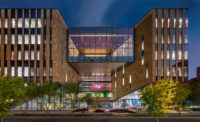"We thought that the Native American market was being underserved and if we brought honesty and integrity to that market, we would be successful," Gabel says. "To get into the Navajo market and do more Native American work, you almost have to have the joint venture part—although we have some [projects] that are not. But in order to be steady participants in those markets, you have to have those connections."
Currently, Bitco-Kitchell is building the $34-million, 70,000-sq-ft Kayenta Multi-Purpose Justice Center in northern Arizona, approximately 25 miles south of Monument Valley. The single-level project, which is scheduled for completion in 2014, includes a 54,000-sq-ft corrections building with 84 beds as well as short-term holding areas for male and female adults and juveniles and a 16,500-sq-ft structure that will primarily be used for dispatch, investigations and other support purposes.
In order to demonstrate that Native American values and ideals are important to Kitchell, the company regularly holds annual Native American Cultural Sensitivity seminars, hosted by Jeff Begay, director of client services for the Native American division and a member of the Navajo Nation. Most seminars include invited guests from various tribal communities who speak to their history and culture.
"[The seminars] are very popular; even people in accounting can and do come because they are just interested," Gabel says.
Growing Design-Build Market
With the trust and buy-in that Kitchell has developed through its relationships with its clients, it has allowed the firm to expand its use of design-build and construction manager at-risk principles, even with clients that traditionally have shied away from those methods.
In 2012, the company began work on designing and constructing a $125-million patient tower at ">Chandler Regional Medical Center in Chandler, Ariz., with Phoenix-based design firm Orcutt/Winslow. The five-story inpatient tower will add 100 beds and will accommodate the hospital's emergency and medical-surgical services, with 30 intensive care rooms, six additional operating suites and ancillary support infrastructure that includes the addition of a chapel.
"Design-build has been a delivery that has been misunderstood over the years," Whitworth says. "The client's biggest fear is a loss of control—that if they turned it over to a design-builder they would get a box when what they wanted was an octagon."
He says the streamlined impacts of design-build will become even more attractive in the future, adding that it is a more harmonious and symbiotic design process that can merge uniqueness with prefabrication.







Post a comment to this article
Report Abusive Comment